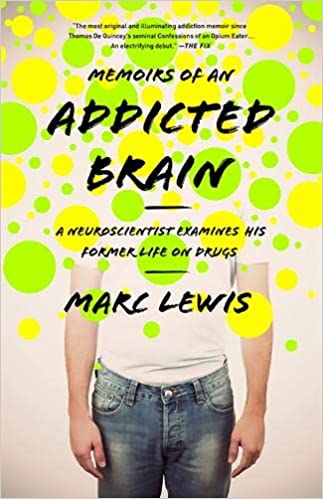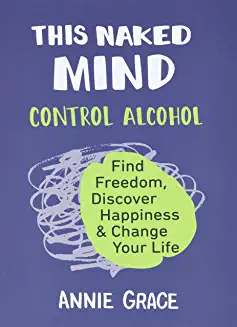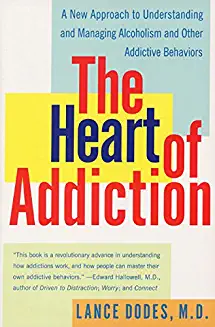Guest blog by Ted Perkins, Facilitator and “Tips & Tools Guy”

Successful recovery from any addiction is a holistic process that involves not just SMART Recovery meetings, but also social support from friends and loved ones, perhaps professional mental health support, and self-guided learning. A great way to learn about your addiction and successful recovery in general, is to read through SMART Recovery’s free on line resources and Toolboxexercises, watch our excellent YouTube videos, purchase our Handbook, and also read books.
Whereas in past decades the number of books available for purchase about addiction were less prevalent, today the publishing industry’s Addiction & Recovery genre is a thriving marketplace that features hundreds of helpful books to inform, entertain, motivate, and inspire anyone on their recovery journey.
Here is my list of the “Top-5 Books That Helped Me Recover” and a brief explanation of why I found the book useful and informative.
BRAIN BUGS: How the Brain’s Flaws Shape Our Lives by Dean Buonamano
Addiction happens in the external world of course, but it’s also manifested in our brains. Addiction is a feedback loop that has gotten out of control. The more we understand the way our own brains can sabotage our “common sense” or “willpower”, the more we may be able to push back and make better decisions. This book analyzes many of the cognitive biases at work in our brains, and how so much of our decision making is guided by neurological algorithms that run without us even consciously knowing about them.
MEMOIRS OF AN ADDICTED BRAIN: A Neuroscientist Examines his Former Life on Drugs
by Marc Lewis, PhD.
Not only is this a page-turner, it’s a fantastic look at addiction told through the lens of someone who not only lived it, but then went on to study it. Lewis has been featured in several TedTalks, and I had the good fortune of interviewing him for a video I produced about addiction several years ago. Part gritty memoir, part science paper, this book is a highly progressive, modern look at addiction not as a disease, but as a treatable behavioral disorder.
IN THE REALM OF HUNGRY GHOSTS by Gabor Mate, M.D.
Mate’s book is considered a must-read in many addiction and recovery communities. He addresses addiction by relating the experiences of several people whom he has treated throughout the years, both successfully and unsuccessfully. The book helps us realize that when it comes to recovery, no one size fits all, and while the mechanics of addiction are identical at a neurological level, each addiction is treatable in different ways.
THIS NAKED MIND by Annie Grace
Grace self-published her book as a way to help process her recovery from an alcohol addiction, never realizing that her manuscript would be picked up by a major publisher and turned into a best-seller. It’s easy to see why. Grace’s stories of her own relationship to alcohol are highly relatable, and the way she approached the solution to her addiction is inspirational. Fans of the book often say “that was me” as she describes her battle with booze.
THE HEART OF ADDICTION: A New Approach to Understanding and Managing Alcoholism and Other Addictive Behaviorsby Lance Dodes, M.D.
Why do people repeat behaviors that are clearly problematic? What is it about us humans that drives us towards 9uick rewards at the cost of long term conse9uences? Dodes explores these and many other topics from the point of view of both a clinician and a psychologist who helps us better understand the role that emotions play in addiction. He also successfully debunks several myths about addiction and argues for a more open-minded approach to treatment based on hard science, less stigma, and more progressive methodologies besides total abstinence or allowing people to hit rock bottom.
PLEASE NOTE BEFORE YOU COMMENT:
SMART Recovery welcomes comments on our blog posts—we enjoy hearing from you! In the interest of maintaining a respectful and safe community atmosphere, we ask that you adhere to the following guidelines when making or responding to others’ comments, regardless of your point of view. Thank you.
- Be kind in tone and intent.
- Be respectful in how you respond to opinions that are different than your own.
- Be brief and limit your comment to a maximum of 500 words.
- Be careful not to mention specific drug names.
- Be succinct in your descriptions, graphic details are not necessary.
- Be focused on the content of the blog post itself.
If you are interested in addiction recovery support, we encourage you to visit the SMART Recovery website.
IMPORTANT NOTE:
If you or someone you love is in great distress and considering self-harm, please call 911 for immediate help, or reach out to 988 Suicide & Crisis Lifeline @ 988, https://988lifeline.org/
We look forward to you joining the conversation!
*SMART Recovery reserves the right to not publish comments we consider outside our guidelines.*
Subscribe To Our Blog
Join our mailing list to receive the latest news and updates from the SMART Recovery Blog.
You have Successfully Subscribed!
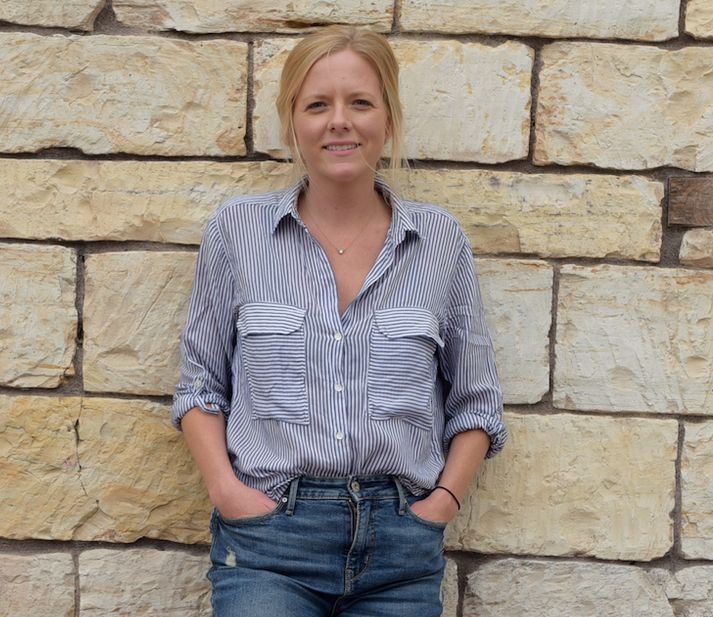
Katie Lain is the co-founder of Thrive Alcohol Recovery, an organization that uses the Sinclair Method to help treat alcohol use disorder (AUD).
Katie struggled a decade trying to get her drinking under control, but no programs or treatments worked. In searching the internet for answers, she found a TedX featuring Claudia Christian, How I Overcame Alcoholism, and thought what she was saying was too good to be true.
Developed by Dr. David Sinclair, the Sinclair Method works by taking naltrexone, an FDA approved medication, 1-2 hours before drinking, to block the pleasure receptors in your brain. With long-term, consistent use, it is medically proven effective at changing a person’s relationship with alcohol.
SMART Recovery is a great compliment to the Sinclair Method because it teaches people tools, like the Hierarchy of Values (HOV) and Cost Benefit Analysis (CBA), to help them understand why they abused alcohol and how to now live life without it.
Check out this great interview by Luke Frazier, for our show Insiders+ Access, made possible in part by the generous support of SMART Insiders+ participants.
The Cure for Alcoholism by Roy Eskapa
For more information on how you can join the SMART Insiders+ Program, go to: www.smartrecovery.org/insiders
Listen as a Podcast:
Click here to find all of SMART Recovery’s podcasts
PLEASE NOTE BEFORE YOU COMMENT:
SMART Recovery welcomes comments on our blog posts—we enjoy hearing from you! In the interest of maintaining a respectful and safe community atmosphere, we ask that you adhere to the following guidelines when making or responding to others’ comments, regardless of your point of view. Thank you.
- Be kind in tone and intent.
- Be respectful in how you respond to opinions that are different than your own.
- Be brief and limit your comment to a maximum of 500 words.
- Be careful not to mention specific drug names.
- Be succinct in your descriptions, graphic details are not necessary.
- Be focused on the content of the blog post itself.
If you are interested in addiction recovery support, we encourage you to visit the SMART Recovery website.
IMPORTANT NOTE:
If you or someone you love is in great distress and considering self-harm, please call 911 for immediate help, or reach out to 988 Suicide & Crisis Lifeline @ 988, https://988lifeline.org/
We look forward to you joining the conversation!
*SMART Recovery reserves the right to not publish comments we consider outside our guidelines.*
Subscribe To Our Blog
Join our mailing list to receive the latest news and updates from the SMART Recovery Blog.
You have Successfully Subscribed!
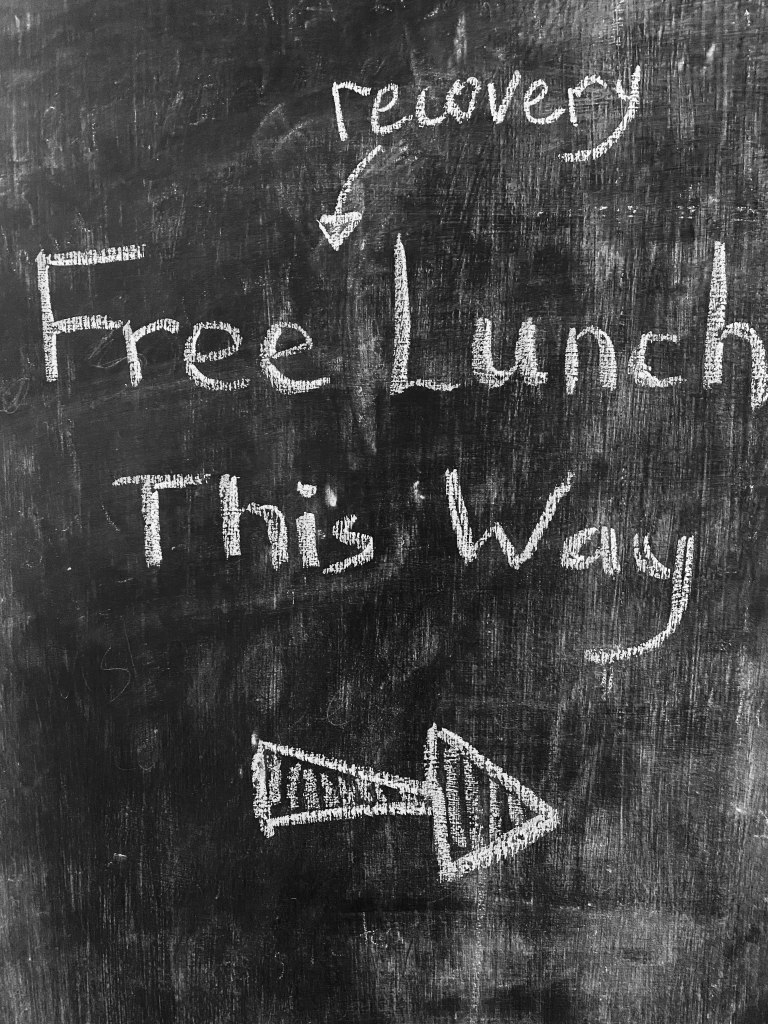
A few years back in my first few months of working full time in addictions, I attended a seminar on mutual aid. Facilitated by an addiction psychiatrist, the meeting was packed with a variety of addiction treatment professionals.
The facilitator laid out the evidence base for mutual aid as it was at the time and discussed how assertively referring to mutual aid organisations could result in high take-up rates with benefits to patients. This was in the days when most groups were 12-step – SMART and other groups were still to be launched locally.
At the interactive part of the presentation the audience was asked ‘what objections might your patient have to attending mutual aid groups’? There were a variety of responses to this: people don’t like AA; many don’t want abstinence; people don’t like speaking groups; it makes people want to drink and use; they are too religious; everyone goes to the pub after an AA meeting; the groups are cult-like; it’s not safe for women etc.
As each objection came up the facilitator gave evidence from literature and from his experience to allay concerns in a robust manner. A curious thing began to happen, as he gave reasonable and, to my mind, fairly convincing reassurances to each objection, many of the participants began to double down, argue, find new objections and the heat in the room went up. Some got irritable and short.
I began to realise what was going on. The professionals were no longer relaying the concerns of their patients, they were relaying their own concerns, or to be frank, they were relaying their own prejudices. This of course, did not apply to some who hold open or positive views.
Some of the reasons for resistance to mutual aid have little to do with mutual aid, but to do with our own reasons for being in the caring professions. For some of us, the prospect of the client leaving our care and managing on their own is a bridge too far. When this is the case it is rarely in consciousness.
What else is going on when some of those who work with people with alcohol and other substance use disorders are antagonistic to mutual aid and lived experience organisations? In the last while I’ve heard a very senior medic dismiss lived experience as ‘fake news’ and assert that recovery communities are unlikely to prevent drug deaths. Recovery discrimination and stigma can be just as potent as addiction stigma.
On Twitter someone who is well respected and works in the field asserted, ‘the biggest risk to drug users is… recovery orgs… bound by a belief system handed down, full of holes, and not fit for now’. So not only not helping, but making things worse?
There are other less ostensibly antagonistic views out there which may be even more damaging. ‘It doesn’t suit everyone’ is often a starting point in discussions with colleagues about mutual aid (this happened in a meeting yesterday incidentally). This approach is a subtle way to remove any enthusiasm or motivation to get serious about connecting people to mutual aid.
When patients have serious medical conditions that need intensive treatments like radiotherapy or IV antibiotics, we don’t initiate the conversation by saying ‘this doesn’t suit everyone’. If the evidence base is good that an intervention is more likely than not to provide benefits we usually come at it with a recommendation to try it, not to immediately stick a flag up that says ‘may not work’.
And does it work? Mutual aid, I mean. Well, yes.
A Cochrane review which examined evidence from 27 published studies involving 10,000 people found AA performed as well as established treatments like cognitive behavioural therapy (CBT) and motivational enhancement (and was free) but better than these when twelve-step facilitation was employed. Abstinence rates where people participated in AA were 42% one year later compared to 35% with other treatments including CBT. The time for confusion about the efficacy of mutual aid is over.
John Kelly, a Professor of Addiction Psychiatry at Harvard University, one of the researchers who co-authored the Cochrane review, has just published a further paper on mutual help organisations,[1] in which he says, “AA and similar freely available community-based 12-step and non-12-step (eg, SMART Recovery) MHOs [mutual help organisations] may be the closest thing public health has to a “free lunch.”
AA is without doubt the most studied mutual aid group with many robust studies now published. Although the same quality of evidence is not available for other mutual aid groups, Kelly writes, “Emerging evidence from statistically controlled prospective observational studies do show positive salubrious relationships between NA participation and better opioid use disorder outcomes, particularly increased abstinence and enhanced adherence to medications for the treatment of opioid use disorder.”
He also reports, “NA mutual-help attendance was associated with twice the rate of abstinence independent of buprenorphine or methadone engagement more than 3 years after entering the trial. Professionally delivered behavioural treatment in that study, on the other hand, was not associated with opioid abstinence.” It is likely that non-12-step mutual aid confers benefits too.
The problem with this free lunch is lack of access. The table is set, the dishes are served, the plates are bountiful and healthy, but relatively few are turning up – though it does not have to be that way. In England, recognising the public health benefits of a free lunch, PHE published a suite of documents to improve uptake.
While we have acknowledgement of the value of mutual aid in policy documents here in Scotland, we still have a blind spot in terms of the emphasis we place on it. If you want evidence, look at the research output on mutual aid from the academic community in Scotland. (I’ll save you time, there is next to none). In Edinburgh in 2010, less than 1% of individuals attending treatment services had ever been to AA. For NA, it was less than half a percent. Think back to those professionals and their views on mutual aid at that seminar I attended. We ought not to be surprised.. I think things are better now than they were then, but not nearly as good as they might be.
Unless you have a drugs or alcohol worker or social or healthcare professional who is aware of the evidence base, who is not carrying conscious or unconscious bias against mutual aid and who knows how to get you to the free lunch then your chance of getting to lift your knife and fork and feast at the recovery table is limited. That’s not okay and it’s got to change.
Continue the discussion on Twitter @DocDavidM
[1] Kelly JF. The Protective Wall of Human Community: The New Evidence on the Clinical and Public Health Utility of Twelve-Step Mutual-Help Organizations and Related Treatments. Psychiatr Clin North Am. 2022 Sep;45(3):557-575. doi: 10.1016/j.psc.2022.05.007. Epub 2022 Aug 1. PMID: 36055739.

Reading about addiction and recovery can be overwhelming and confusing. Media reports and experts often make strongly worded statements that are contradicted by statements from other media sources and experts. Other times, they seem to negate or minimize the lived experience of people with drug or alcohol problems and their families.
For example, it’s very common for press releases, media reports and, occasionally, researchers to make statements about a study demonstrating the effectiveness of a particular intervention. Other times, we hear people say something like, “science shows that [insert intervention] works.”
However, when we look closely at the study, we may find that the outcomes don’t fit our idea of “effectiveness” or “works.” Further, the conditions and subjects don’t resemble the real world.
This isn’t confusing just for lay people, it’s confusing for professionals and policymakers too. And, to make matters worse, most of us are pretty reluctant to question statements presented as science or evidence-based.
For this reason, I’ve been working on a guide that will hopefully allow anyone to review a study and evaluate its relevance to its goals. This way you can make an informed evaluation rather than having to rely on the reporting of others, who may see things through their own bias or interests. The guide is based on the following questions.
- What is the treatment or intervention being studied?
- Who were the subjects?
- How long was the study?
- What outcomes did the study measure? (How did they define success?)
- What were the study methods?
- What were the actual findings and does the authors’ discussion accurately represent the findings?
- Were there any conflicts of interest (real or potential)?
- What questions does the study not answer?

1) What is the treatment or intervention being studied?
It’s important to pay close attention to the intervention being studied. It is common for news reports about the study to describe it poorly. Further, it’s common for the study itself to obscure the details of the intervention.
Interventions might include:
- Medication with, or without, counseling
- Opioid agonist medication
- Opioid antagonist medication
- Other medications
- Education
- Medical care
- Harm reduction
- Case management
- Mutual aid groups such as 12-step meetings, faith-based meetings (Without professional treatment)
- Specific types of counseling or combinations of them, such as:
- Motivational Interviewing
- Twelve-step facilitation (Professionally directed treatment focused on linking and encouraging active participation in 12-step organizations.)
- Relapse Prevention Therapy
- Cognitive Behavioral Therapy
It’s also important to know more about how the treatment was delivered:
- Residential treatment
- Long term
- Short term
- Outpatient
- How often? Once a week, or multiple times per week?
- Over what period of time?
- Was it linked to additional services intended to support problem resolution over months and years, rather than days and weeks?
- Does the treatment in the study resemble how treatment is provided in the real world?
Question 2: Who were the subjects?
There is a wide spectrum of alcohol and other drug problems, with addiction on the most severe end and misuse on the less severe end. Further, there can even be considerable variation within a category. Additionally, there can be significant differences in where the subjects are found as well as their life experience or current conditions.
- Where were the subjects found?
- Community population – Are the study’s findings based on a sample from the community?
- Clinical population – Are the study’s subjects drawn from a treatment population or a treatment-seeking population?
- If they are a treatment population, what kind of treatment were they receiving? Methadone, office-based buprenorphine, outpatient, residential, case management, etc.?
- Something else – Some studies draw subjects from medical clinics, child protection cases, college students, mental health clinics, professional monitoring programs, corrections settings, etc.
- What were the demographics of the subjects?
- Recovery capital
- Are they high recovery capital clients with financial, social, family, environmental, or cultural resources to help them achieve AOD problem resolution?
- Are they low recovery capital clients with few financial, social, family, environmental, or cultural resources to help them achieve AOD problem resolution?
- Did the exclusionary criteria result in a group of subjects with a single problem? Meaning that they do not resemble real-world treatment populations?
- Recovery capital
- What kind of AOD problem did the subjects have?
- Substance use disorders (SUD) – This model is based on the DSM-5 and includes a broad spectrum of substance use problems ranging from addiction to misuse. It also may include any substance. Look for specifiers like mild, moderate, and severe to get a better understanding of the population.
- Words like “Dependence” or “Abuse” – DSM dependence constitutes a more severe substance use problem (it may, or may not, be addiction), while abuse is considered mild in severity.
- Substance specific – Some studies include subjects with a particular substance problem, others include polysubstance users. Many recent studies looked specifically at people with prescription opioid problems.
- Chronic vs acute – Some studies include subjects with long-term chronic problems, while others may focus on populations with short-term acute problems.
3) How long was the study?
Robert DuPont once observed, “The most striking thing about substance abuse treatment is the mismatch between the duration of treatment and the duration of the illness.” 1
Addiction is a chronic disease and recovery is a long-term process, but research is often limited to days and weeks.
The longer the study, the better. For example, Dennis, Foss, and Scott 2 found relapse rates of 64% for people between 1 and 12 months abstinent. Those relapse rates drop to 34% for people with between 1 and 3 years abstinent.
Therefore, a study that reports on any outcome at less than one year may say very little about what can be expected long term.
Look for studies that report on outcomes after one year.
4) What outcomes did the study measure? (How did they define success?)
Outcomes measured in research do not necessarily correspond well with the outcomes patients are seeking.
Common outcomes include:
- retention in treatment
- illicit opioid use
- mortality
- illicit drug use (non-opioid)
- criminal activity
- HIV risk behaviors
Less common outcomes include:
- abstinence from alcohol and other drugs
- quality of life measures like employment, housing, and family status.
The implications for this are profound. For example, a study may investigate the effects of a treatment on people with opioid use disorders. If the study is only examining the impact of the treatment on illicit opioid use, the treatment could be described as effective when subjects sustain alcohol, cocaine, or prescription opioid problems.
Consider the outcomes you want for yourself or your loved one. Then, determine whether the study’s outcomes match your desired outcomes.
5) What were the study methods?
There are many approaches used in SUD research and each approach offers advantages and disadvantages in different situations. Methods include experimental (including randomized control trials), qualitative, case studies, meta-analysis, and observational.
It’s often said that randomized controlled trials (RCTs) are the gold standard for research. It’s important to keep a few things in mind about them. First, they lend themselves to studying easily quantifiable outcomes, which means they tend to focus on relatively narrow outcomes in relatively narrow contexts. Second, they tend to be very expensive, which means that they often only get done with financial backing from large institutions (public or private). Third, in some cases, their use may be limited by ethical problems related to using placebos or blinded treatments. Finally, they tend to eclipse experiential and local knowledge.
It’s also important to look at other factors, for example:
- the number of subjects in the study;
- whether outcome numbers were based on all subjects or just those retained in the study;
- what measures/data were (e.g. self-report or urine drug screens).
6) What were the actual findings and does the authors’ discussion accurately represent the findings?
This sounds very straightforward, but it often requires a lot of effort to answer this question. Outcomes are sometimes reported very clearly in raw numbers and percentages, other times they are reported in the form of statistical terms that can be a challenge to decipher.
- Do the discussion and conclusions focus on findings that support one theory/model/approach and ignore others?
- Do the discussion and conclusions overstate the real-world implications of the findings?
- Keep in mind that statistical significance may not translate into significant improvements in quality of life.
- Study definitions often differ from real-world definitions. For example, a recent study set a threshold for treatment engagement as taking medication for 10 or more days per month. This study was careful to characterize their findings as “increased days of medication treatment.” However, it’s easy to imagine another study or press release reporting 69% retention at 6 months.
- Finally, it’s important to ask whether the authors accurately represent the findings of its references. (For example, a 1980 letter to the editor was misrepresented and is believed to have profoundly misinformed opioid pain management policies.)
7) Were there any conflicts of interest (real or potential)?
A conflict of interest is a situation in which financial or other personal considerations have the potential to compromise or bias judgment and objectivity. It is worth noting that a conflict of interest exists whether or not decisions are affected by a personal interest.
Conflicts of interest can lead to more than unreliable information about particular treatments. For example, Stenius (2016) described alcohol and tobacco industry’s influence on the assumptions underlying policy decisions.
It is well documented how the tobacco industry for decades funded research aimed at producing uncertainty about the danger of smoking (e.g., Brandt, 2012). For alcohol, the transnational producers have invested resources in research that questions the relation between the total consumption and alcohol-related harms on a population level to prevent general regulations of the alcohol market (Adams, 2016).Stenius, Kerstin. (2016). Addiction journals and the management of conflicts of interest. The International Journal of Alcohol and Drug Research. 5. 9.
8) What questions does the study not answer?
No study can answer every question, nor should any study seek to every question. However, it can be helpful to stop and ask, what questions does the study not answer?
There are two ways to group these questions.
First, there are questions that simply cannot be answered by the study. Considering what was asked, and not asked, provides context for the study.
Second, and maybe more important, is what questions does the study appear to have data for, but chose not to answer? For example, if a study looks at the impact of a treatment on drug use, as measured by urine drug screens, does it report on the number of subjects who were continuously abstinent?
- DuPont R. (March, 2018). Interview with Brian Coon. Interview presented at the NC Recovery Alliance Summit, Durham, NC.
- Dennis, M. L., Foss, M. A., & Scott, C. K. (2007). An Eight-Year Perspective on the Relationship Between the Duration of Abstinence and Other Aspects of Recovery. Evaluation Review, 31(6), 585–612.
You’ve probably heard “90 meetings in 90 days” before, somewhere during your recovery journey – 90 in 90 is a major method of maintaining recovery once you’re out of treatment and back in the real world. Although it may not seem easy to make room for meetings in your schedule, there are many benefits to consistently attending meetings throughout your recovery. Here are a few reasons to encourage you to stay the course:
- Make new friends
It’s not unusual to outgrow some of the relationships you had when you were using. You may find that most of the people around you are your recovery friends who understand your challenges. Attending meetings will give you an opportunity to build new friendships with those who share goals similar to yours.
- Learn how to conquer cravings
Cravings are normal. Everyone who has engaged in addictive behavior in the past will experience uncomfortable cravings during recovery. The good news: cravings will subside if you work your plan. Recovery meetings can help you learn new coping strategies in a supportive environment, while you determine what works best for you.
- See your Higher Power at work
With so many distractions, it can be difficult to see a Higher Power at work in your life each day. Hearing your friends share their personal miracles at meetings, it becomes easier to see the ways your Higher Power is at work in everyday life. You’ll get to a point where you’ll begin sharing your own stories, showcasing how your Higher Power is guiding you on your recovery journey.
- Have people to hold you accountable
There is a long list of to-dos when it comes to living a life in recovery. It can be overwhelming but having a community to help hold you accountable is important. Connecting with your peers at meetings allows you to have people who can check in with you and help you stay on course. Support from others in recovery is essential – your recovery network can provide insight and understanding that friends and family might not be able to give you.
- Know you’re not alone
In active addiction, it’s not uncommon to isolate yourself from friends and family. But in recovery, you come to know that you are not alone. Meetings can give you a sense of belonging and an opportunity to stay connected to a vital support community.
Attending meetings can help you prevent the occurrence of a relapse, see the miracles in your life and provide you with the opportunity to give to and receive from others. Meetings also provide a consistent schedule and continually reinforce the building of strong habits – you’re more likely to stick with your meetings once they’re an ingrained part of your daily routine, and the same goes for your recovery. Be encouraged to find your closest meeting and get involved. It can make all the difference.
***
For more information, resources, and encouragement, “like” the Fellowship Hall Facebook page and follow us on Instagram at @FellowshipHallNC.
About Fellowship Hall
For 50 years, Fellowship Hall has been saving lives. We are a 99-bed, private, not-for-profit alcohol and drug treatment center located on 120 tranquil acres in Greensboro, N.C. We provide treatment and evidence-based programs built upon the Twelve-Step model of recovery. We have been accredited by The Joint Commission since 1974 as a specialty hospital and are a member of the National Association of Addiction Treatment Providers. We are committed to providing exceptional, compassionate care to every individual we serve.

Demonstrated solutions to alcohol and drug problems will do more to reduce the stigma attached to these conditions than will endless debates about the source of such problems.
(Photo credit: beware of pity by shawnzrossi)
I often talk about how substance use and substance use disorders (SUDs) change the brain, but that malleability (plasticity) is multifaceted. While drugs change the brain, lived experiences, aging, and treatment change it too.
Cessation or potentially even reduction of substance use, for example through treatment, can heal the brain and in doing so drive positive changes in emotion, cognition, and behavior that can facilitate recovery. When people enter treatment for an SUD, it should be with the knowledge and understanding that recovery is achievable.
But while treatments such as medications for opioid use disorder (MOUD) or behavioral approaches like cognitive behavioral therapy or contingency management address the biological and behavioral dimensions of an SUD, changes in the brain and behavior take time, as does resolving the radiating impacts of an SUD on an individual’s life. Those impacts may include job loss, loss of housing, fractured relationships with family and friends, and involvement in the criminal justice system. People may need ongoing support and help with these issues to maintain and sustain their recovery.
A wide range of services and supports have been developed, including recovery housing, recovery high schools (for adolescents and young adults), as well as the many community- and faith-based organizations such as mutual aid groups that have long augmented and in many cases substituted for treatment when the latter was not available or desired. These services not only provide essential social connection with peers who understand and support their recovery, they may also make it easier for people to continue with treatment or reenter treatment when needed.
Unfortunately, much less is known about recovery supports than about treatment, such as which kinds of services are most effective, how they work, and how they are best adapted to the needs of different people. Without that knowledge of efficacy, insurers and other payers may not cover these potentially useful components of the care spectrum, and people may not know which to choose.
NIDA has been supporting research on peer and community-based recovery supports, active recovery communities, and recovery modalities that integrate multiple services, such as recovery residences. But more focus is still needed on this topic, to build foundational knowledge of these services and thus better advance this part of the U.S. Department of Health and Human Services Overdose Prevention Strategy. To that end, the Helping to End Addiction Long-term® Initiative, or NIH HEAL Initiative®, with funding from NIDA, is supporting several additional research projects that will add to our knowledge of recovery residences, clinical continuing care, linkage to recovery community centers, and peer interventions to increase retention in treatment with MOUD.
Three of the new grants will develop resources to study recovery support services. One will establish a collaborative Peer Recovery Innovation Network (PRIN) that will develop resources for training and mentoring, as well as infrastructure to advance the science on facilitating continuation of care through these services after people are initiated on MOUD, as well as on such services delivered via technology, specifically for Hispanic/Latino/a people near the US-Mexico border and in other underserved areas. Another project will develop a network of researchers, recovery support specialists, and young adults (ages 18-25) in recovery, to advance our understanding of recovery support services for people in that age group who take MOUD, especially those with co-occurring mental disorders and polysubstance use. Another project will focus on developing tools and methods to better study the effectiveness of recovery residences for individuals who take MOUD.
Three grants will support trials of the effectiveness of recovery supports or the planning of such trials. One will develop an integrated intervention involving peer recovery coaching and cognitive behavioral therapy for opioid use disorder to enhance retention in MOUD treatment. Another will study the effectiveness of peer recovery support in helping people living in recovery residences remain in MOUD treatment or reengage in treatment after dropping out or after being discharged from a recovery residence. And another grant will support the planning of a multi-site trial to examine the effectiveness of recovery community centers serving Black communities to support people using MOUD.
A supplement to an existing grant will develop a coordinated infrastructure and a research agenda for the Consortium on Addiction Recovery Science (CoARS), which was initiated by five research teams previously funded by NIDA that will be expanded with funds from HEAL. This supplement provides sufficient resources to help the researchers coordinate their research and training efforts, harmonize their data and metrics, support diversity in the consortium, and ensure its sustainability, as well as organize the first national meeting on recovery support services science.
One of the themes that has emerged from the NIDA focus on recovery and recovery supports is the impressive ingenuity and proactiveness of people working in the field to develop novel solutions to address the rapidly evolving addiction and overdose crisis. Many of these researchers and other participants in these projects are themselves in recovery or have lived experience of addiction.
One of the cross-cutting themes of NIDA’s new FY 2022-2026 Strategic Plan is greater involvement of people with lived experience in research design, and the science of recovery supports is emblematic of how successful that mindset can be.
It is people on the front lines of the addiction and overdose crisis, peers finding innovative ways to help peers. NIDA’s role is to support research to determine which new approaches are most effective, and these new grants will facilitate the translation of that knowledge into interventions to help individuals with SUDs achieve recovery.

…I do want to suggest that something got lost along the road to professionalization. What got lost was a relationship between two people that transcended the roles of counselor and client. What got lost was our deep involvement in the community and in local communities of recovery. What got lost was our recognition of the power of community to heal and sustain people. John McKnight in his recent book, The Careless Society: Community and Its Counterfeits, argues that compassion shifted from a cultural value to a job description as paid helping roles replaced functions of families, extended families, neighbors, co-workers and friends. He argues that we don’t need more agencies or larger agencies, but that we desperately need more community. In medicalizing alcohol and other drug problems in hopes we could escape its social stigma and moral censure, we turned our backs on the power of community and created an ever-growing distance between ourselves and those we are pledged to serve. Perhaps it is time we went back and discovered what was of value along that road we didn’t take.
(Photo credit: “a fork in the road” by pipiwildhead is licensed under CC BY-NC-ND 2.0.)

September is National Recovery Month, but many advocates point out we can certainly recognize recovery year-round, including Keegan Wicks. He is the National Advocacy and Outreach Manager for Faces & Voices of Recovery. He works to ensure that the recovery spectrum of services is available and funded for anyone who needs them.
In this podcast, Keegan talks about:
- Why it’s okay to say “Happy” Recovery Month
- How Recovery Month started and has changed throughout the years
- His personal journey with mental health and substance use disorders
- How his family network helped him navigate the often-complicated recovery system
- Why the systems and access to recovery should never be a result of good luck and privilege
- The inner voice that led him to get involved and affect change
- Being the voice at the table with lived experience in recovery
- Faces & Voices of Recovery’s focus and core messages of accessibility and inclusiveness
- Helping organizations be “recovery ready”
- How Congress is helping with prevention, treatment, and recovery efforts
- Why it’s an exciting time to highlight and show what recovery can look like
- How to get involved in Recovery Month initiatives, and why to stay involved
Additional resources:
Click here to find all of SMART Recovery’s podcasts
PLEASE NOTE BEFORE YOU COMMENT:
SMART Recovery welcomes comments on our blog posts—we enjoy hearing from you! In the interest of maintaining a respectful and safe community atmosphere, we ask that you adhere to the following guidelines when making or responding to others’ comments, regardless of your point of view. Thank you.
- Be kind in tone and intent.
- Be respectful in how you respond to opinions that are different than your own.
- Be brief and limit your comment to a maximum of 500 words.
- Be careful not to mention specific drug names.
- Be succinct in your descriptions, graphic details are not necessary.
- Be focused on the content of the blog post itself.
If you are interested in addiction recovery support, we encourage you to visit the SMART Recovery website.
IMPORTANT NOTE:
If you or someone you love is in great distress and considering self-harm, please call 911 for immediate help, or reach out to 988 Suicide & Crisis Lifeline @ 988, https://988lifeline.org/
We look forward to you joining the conversation!
*SMART Recovery reserves the right to not publish comments we consider outside our guidelines.*
Subscribe To Our Blog
Join our mailing list to receive the latest news and updates from the SMART Recovery Blog.
You have Successfully Subscribed!
" data-medium-file="https://recoveryreview433597834.files.wordpress.com/2022/09/pexels-photo-1111372-1.jpeg?w=300" data-large-file="https://recoveryreview433597834.files.wordpress.com/2022/09/pexels-photo-1111372-1.jpeg?w=656" src="https://recoveryreview433597834.files.wordpress.com/2022/09/pexels-photo-1111372-1.jpeg" alt class="wp-image-24876">
Eve Tushnet, from a list of 5 things the disease model gets wrong about addiction:
It isn’t mercy. If someone genuinely did not choose to do wrong then compassion for that person isn’t mercy—it’s justice. And conversely, if you can only have compassion on someone if you believe she did not choose her misdeeds, then you’ve defined mercy out of existence. You’re not forgiving—you’re saying there was never anything to forgive.
Eve Tushnet in 5 Things the Disease Model Gets Wrong About Addiction
(Photo by Miguel u00c1. Padriu00f1u00e1n on Pexels.com)


